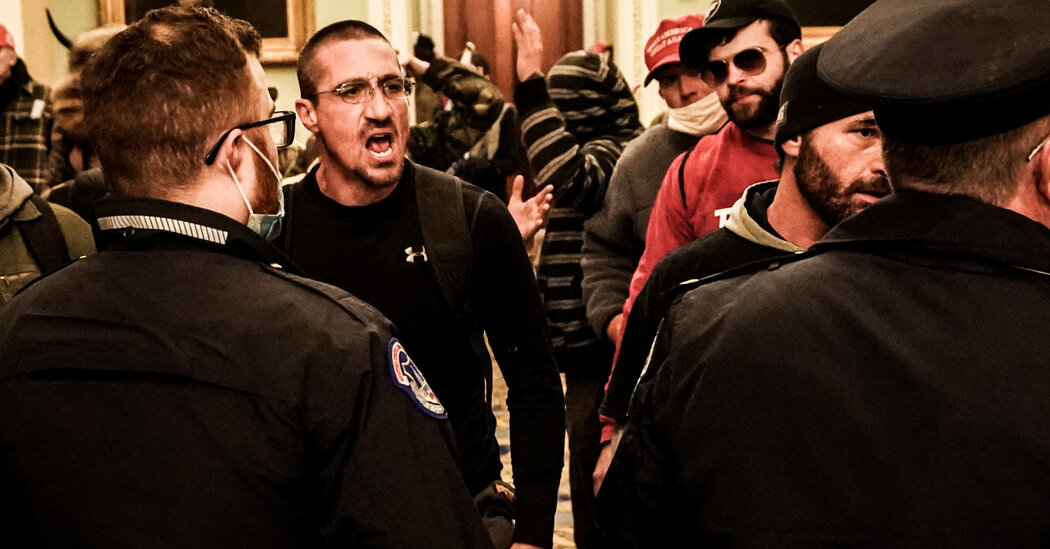Confronting the Threat of QAnon

PASTELS AND PEDOPHILES
Inside the Mind of QAnon
By Mia Bloom and Sophie Moskalenko
A cult. A singularity. An amorphous blob. These are just a few ways researchers have described QAnon, the baseless conspiracy theory that has morphed into a movement so robust that two acolytes now hold seats in Congress and dozens — if not hundreds — more participated in the Jan. 6 insurrection. While frustrating for people in the business of using words to convey precise meaning, the fact that QAnon defies easy definition is exactly what makes it so powerful.
A recent poll found that 15 percent of Americans believe there is a cabal of liberal elites who worship Satan and traffic children for sex and blood. This is QAnon’s core tenet, but the movement contains multitudes. Adherents believe Donald J. Trump is battling the cabal, which, depending on whom you ask, may or may not comprise members of a reptilian alien race disguised as humans. Many followers also embrace conspiracy theories about Covid-19, Black Lives Matter, vaccines and the death of John F. Kennedy Jr. Skepticism and bigotry unite these disparate theories; authority, expertise and otherness are always suspect.
In “Pastels and Pedophiles,” Mia Bloom and Sophie Moskalenko, both experts on extremist radicalism, offer their own description of this bizarre new feature of American life. “We consider QAnon to be like a sticky ball, rolling down a hill,” they write. “It picks up other conspiracies and their supporters along the way — growing ever larger over time.” Believers can cherry-pick ideas to suit their needs.
Bloom and Moskalenko seek to understand why people believe QAnon’s outlandish notions in defiance of all knowledge and reason. “Pastels and Pedophiles” is at its strongest when it drills down on this front, showing that QAnon offers people a false sense of agency and community in an uncertain world. Believers collectively analyze “crumbs” of cryptic information. The outcome of this deciphering is preordained, but that’s not the point: When they reach conclusions, followers feel smart, superior and united. Particularly for people who are lonely or disenchanted with their lives, the emotional benefit of believing in QAnon is arguably more important than the dogma itself. The same goes for people introduced to QAnon through the hashtag #SavetheChildren, which the movement co-opted in 2020. New supporters were told that spreading a message about the threat of pedophilia made them righteous crusaders.
Where “Pastels and Pedophiles” stumbles is on matters of race and gender. The authors dance around the intersections of QAnon and white supremacy, never tackling them in earnest. They note that most QAnon believers arrested for storming the Capitol came from battleground states, but they don’t discuss how racial identity may have informed the participants’ “psychological distress” over “changing culture and eroding social norms.” (The Jan. 6 insurrectionists were overwhelmingly white.) Meanwhile, the authors paint a terrifying picture of how suburban white women have pulled QAnon from the internet’s shadowy corners into pastel-hued Instagram squares — but their description of what motivates “QAmoms” is underdeveloped. They suggest some combination of “innate altruism” and “motherly instincts,” along with a desire to make social activism easy: “Women who did not feel comfortable with ‘political’ topics like Black Lives Matter could engage with strangers online without triggering uncomfortable exchanges. Who would object to saving the children?” But for many women, the children in question aren’t literal — “they are a symbol, a disembodied idea of innocence and goodness.” The book leaves dangling threads about white women’s self-interest masquerading as selflessness; the weaponization of their comfort; and what QAmoms’ notion of “innocence and goodness” might really mean.
“Pastels and Pedophiles” is a primer on one of the knottiest subjects of our time, and it will surely be helpful to uninitiated readers. But the sticky ball whose roll is shaking America has complex engineering. Only with a complete blueprint can we hope to combat it.


